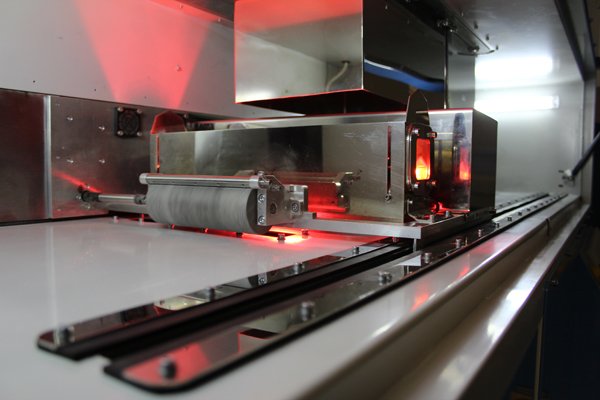High Speed Sintering Builds Small Parts in Seconds

The High Speed Sintering process at work in the laboratory. Courtesy of the University of Sheffield.
Latest News
March 27, 2014
Additive manufacturing (AM) offers a solution to any number of production issues, particularly for designs with complex internal geometries and, of course, for rapid prototyping. Beyond prototyping, the word “rapid” can get lost. For small production runs or one-off designs, it’s hard to beat the speed offered by AM. For large production runs, processes such as injection molding are faster than 3D printing.
Loughborough University and FaraPack Polymers (a subsidiary of the University of Sheffield) have developed the first AM system that may put the lie to notions that 3D printing is too slow for serious production. Able to produce finished parts in around 10 seconds, the High Speed Sintering (HSS) process could well represent the next step forward for full production AM.

In development for over five years, HSS uses a combination of new and old processes to build objects in a fraction of the time as other 3D printers. The prototype machine, called FACTUM, uses inkjet print heads to lay down a binding agent in a bed of powdered material. In place of a laser to sinter the materials together, the new system uses infrared heating lamps, which can affect a larger area more quickly than lasers. Currently, FACTUM can produce finger-sized parts in around 10 seconds, and researchers are positive they can speed up the machine further.
In addition to speed, HSS is also capable of accuracy. Renishaw found that tolerances were within ± 0.05mm, which actually represents an improvement over pieces built using laser sintering. According to Renishaw, laser sintered parts often fall up to 0.4mm out of their required tolerance of 0.2mm on the straight edges.
Another area in which Loughborough University researchers found improvement was in costs. Because HSS is capable of producing multiple builds more quickly than other AM processes, overall production costs fall. For example, Burton Snowboards typically uses laser sintering to produce miniature snowboards to demonstrate its latest designs to potential clients. According to a recent study, researchers found a 75% cost reduction when manufacturing the miniature snowboards with HSS rather than with laser sintering.
The FACTUM 3D printer may also offer new opportunities in materials. Researchers claim that a number of materials which react poorly to laser sintering have no problems being used in HSS. This is the result of the way in which materials are heated. The infrared heating lamps used in HSS provide a much gentler heat source than the sudden change in temperature caused by a laser.
Below you’ll find a video about AM from the University of Sheffield, which includes a segment on HSS.
Source: Loughborough University
Subscribe to our FREE magazine, FREE email newsletters or both!
Latest News
About the Author
John NewmanJohn Newman is a Digital Engineering contributor who focuses on 3D printing. Contact him via [email protected] and read his posts on Rapid Ready Technology.
Follow DE





